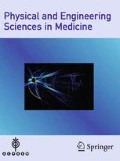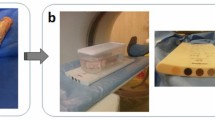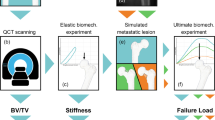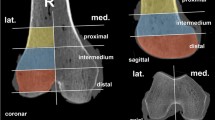Abstract
Lack of quantitative, biomechanical criteria to predict the risk of fracture for a bone affected by giant cell tumor (GCT) has made the decision for the necessary surgical technique a dilemma. The purpose of this study is to critically assess the usefulness of quantitative computed tomography (QCT) based structural rigidity analysis (QCSRA) and QCT-based finite element analysis (FEA) in predicting the fracture risk for long bones reconstructed with bone cement. QCSRA, QCT-based FEA, and in-vitro mechanical tests on five pairs of cadaveric distal femora were employed to quantitatively assess the compressive failure load of the human femur affected by GCT and reconstructed with bone cement. QCT was utilized to investigate the bone’s structural rigidity properties as well as to generate heterogeneous finite element models using written material mapping codes. In order to validate the QCSRA and QCT-based FEA results, their outcomes were compared with the results of in-vitro mechanical tests on human cadavers. Results of this study demonstrated an acceptable correlation between QCSRA fracture loads and fracture loads found in in-vitro mechanical tests on cadavers (R2 = 0.85). Also, QCSRA procedure is developed in order to estimate the axial stiffness and the maximum bending stiffness of the bone, employing the QCT-scans. It is shown that these two features, describing the structural rigidity, are linked to the experimental fracture loads (R2 = 0.72 for axial stiffness, R2 = 0.79 for maximum bending stiffness). Moreover, a good correlation was found between the fracture loads determined by QCT-based FEA and the experimental in-vitro fracture loads (R2 = 0.92). Results of this study confirm the usefulness of the applications of QCSRA and QCT-based FEA as clinically tools for predicting the failure load of a long bone.



Similar content being viewed by others
References
Cowan RW, Singh G (2013) Giant cell tumor of bone: a basic science perspective. Bone 52(1):238–246
Anwar Ul Haque AM (2008) Giant cell tumor of bone: a neoplasm or a reactive condition? Int J Clin Exp Pathol 1(6):489
Singh S, Singh M, Mak I, Ghert M (2013) Expressional analysis of GFP-tagged cells in an in vivo mouse model of giant cell tumor of bone. Open Orthop J 7:109–113
Balke M, Neumann A, Szuhai K, Agelopoulos K, August C, Gosheger G, Hogendoorn PC, Athanasou N, Buerger H, Hagedorn M (2011) A short-term in vivo model for giant cell tumor of bone. BMC Cancer 11(1):241
Ghouchani A, Rouhi G (2017) The great need of a biomechanical-based approach for surgical methods of giant cell tumor: a critical review. J Med Biol Eng 37(4):454–467
Chakarun CJ, Forrester DM, Gottsegen CJ, Patel DB, White EA, Matcuk GR Jr. (2013) Giant cell tumor of bone: review, mimics, and new developments in treatment. RadioGraphics 33(1):197–211. https://doi.org/10.1148/rg.331125089
Ayerza MA, Aponte-Tinao LA, Farfalli GL, Lores Restrepo CA, Muscolo DL (2009) Joint preservation after extensive curettage of knee giant cell tumors. Clin Orthop Relat Res 467(11):2845–2851
Ruskin J, Caravaggi P, Beebe KS, Corgan S, Chen L, Yoon RS, Patterson FR, Hwang JS (2016) Steinmann pin augmentation versus locking plate constructs. J Orthop Traumatol 17(3):249–254
Bickels J, Meller I, Malawer M (2004) The biology and role of cryosurgery in the treatment of bone tumors. Musculoskeletal cancer surgery. Springer, Dordrecht, pp 135–145
Benevenia J, Rivero SM, Moore J, Ippolito JA, Siegerman DA, Beebe KS, Patterson FR (2017) Supplemental bone grafting in giant cell tumor of the extremity reduces nononcologic complications. Clin Orthop Relat Res 475(3):776–783
Chanasakulniyom M, Aroonjarattham K, Aroonjarattham P, Saktaveekulkit N, Sitthiseripratip K, Mahaisavariya B (2011) The effect of distal femur after replace with biomaterials: finite element analysis. In: The second TSME international conference on mechanical engineering Krabi, pp 19–21
Li J, Wodajo F, Theiss M, Kew M, Jarmas A (2013) Computer simulation techniques in giant cell tumor curettage and defect reconstruction. Comput Sci Eng 15(2):21–26
Rennick JA (2012) Bone fracture prediction using computed tomography based rigidity analysis and the finite element method. Northeastern University
D’Elia G, Caracchini G, Cavalli L, Innocenti P (2009) Bone fragility and imaging techniques. Clin Cases Min Bone Metab 6(3):234–246
Villa-Camacho JC, Iyoha-Bello O, Behrouzi S, Snyder BD, Nazarian A (2014) Computed tomography-based rigidity analysis: a review of the approach in preclinical and clinical studies. BoneKEy reports 3
Rennick JA, Nazarian A, Entezari V, Kimbaris J, Tseng A, Masoudi A, Nayeb-Hashemi H, Vaziri A, Snyder BD (2013) Finite element analysis and computed tomography based structural rigidity analysis of rat tibia with simulated lytic defects. J Biomech 46(15):2701–2709
Zhang M, Gao J, Huang X, Gong H, Zhang M, Liu B (2017) Effects of scan resolutions and element sizes on bovine vertebral mechanical parameters from quantitative computed tomography-based finite element analysis. J Healthc Eng. https://doi.org/10.1155/2017/5707568
Viceconti M, Qasim M, Bhattacharya P, Li X (2018) Are CT-based finite element model predictions of femoral bone strengthening clinically useful? Curr Osteoporos Rep 16(3):216–223
Damron TA, Nazarian A, Entezari V, Brown C, Grant W, Calderon N, Zurakowski D, Terek RM, Anderson ME, Cheng EY (2016) CT-based structural rigidity analysis is more accurate than mirels scoring for fracture prediction in metastatic femoral lesions. Clin Orthop Relat Res 474(3):643–651
Eggermont F, Derikx L, Verdonschot N, Van der Geest I, De Jong M, Snyers A, Van der Linden Y, Tanck E (2018) Can patient-specific finite element models better predict fractures in metastatic bone disease than experienced clinicians? Towards computational modelling in daily clinical practice. Bone Joint Res 7(6):430–439
Jeys L, Suneja R, Chami G, Grimer R, Carter S, Tillman R (2006) Impending fractures in giant cell tumours of the distal femur: incidence and outcome. Int Orthop 30(2):135–138
Hirn M, de Silva U, Sidharthan S, Grimer RJ, Abudu A, Tillman RM, Carter SR (2009) Bone defects following curettage do not necessarily need augmentation: a retrospective study of 146 patients. Acta Orthop 80(1):4–8
An YH, Draughn RA (1999) Mechanical testing of bone and the bone-implant interface. CRC Press, Boca Raton
Mirzaei M, Keshavarzian M, Naeini V (2014) Analysis of strength and failure pattern of human proximal femur using quantitative computed tomography (QCT)-based finite element method. Bone 64:108–114
Samsami S, Saberi S, Sadighi S, Rouhi G (2015) Comparison of three fixation methods for femoral neck fracture in young adults: experimental and numerical investigations. J Med Biol Eng 35(5):566–579
Keyak JH, Falkinstein Y (2003) Comparison of in situ and in vitro CT scan-based finite element model predictions of proximal femoral fracture load. Med Eng Phys 25(9):781–787
Anez-Bustillos L, Derikx LC, Verdonschot N, Calderon N, Zurakowski D, Snyder BD, Nazarian A, Tanck E (2014) Finite element analysis and CT-based structural rigidity analysis to assess failure load in bones with simulated lytic defects. Bone 58:160–167
Hong J, Cabe GD, Tedrow JR, Hipp JA, Snyder BD (2004) Failure of trabecular bone with simulated lytic defects can be predicted non-invasively by structural analysis. J Orthop Res 22(3):479–486
Keaveny TM, Wachtel EF, Ford CM, Hayes WC (1994) Differences between the tensile and compressive strengths of bovine tibial trabecular bone depend on modulus. J Biomech 27(9):1137–1146
Snyder BD, Cordio MA, Nazarian A, Kwak SD, Chang DJ, Entezari V, Zurakowski D, Parker LM (2009) Noninvasive prediction of fracture risk in patients with metastatic cancer to the spine. Clin Cancer Res 15(24):7676–7683
Samsami S, Saberi S, Bagheri N, Rouhi G (2016) Interfragmentary motion assessment for three different fixation techniques of femoral neck fractures in young adults. Bio-Med Mater Eng 27(4):389–404
Ghouchani A, Rouhi G, Ebrahimzadeh MH (2019) Investigation on distal femoral strength and reconstruction failure following curettage and cementation: in-vitro tests with finite element analyses. Comput Biol Med 112:103360
Aroonjarattham P, Aroonjarattham K, Chanasakulniyom M (2015) Biomechanical effect of filled biomaterials on distal Thai femur by finite element analysis. Kasetsart J Nat Sci 49(2):263–276
Chang C-H, Hsu J-T, Chen S-I, Chen W-P, Chang G-L (2002) The effect of material inhomogeneous for femoral finite element analysis. J Med Biol Eng 22(3):121–128
Dall’Ara E, Pahr D, Varga P, Kainberger F, Zysset P (2012) QCT-based finite element models predict human vertebral strength in vitro significantly better than simulated DEXA. Osteoporos Int 23(2):563–572
Zysset PK, Dall’Ara E, Varga P, Pahr DH (2013) Finite element analysis for prediction of bone strength. BoneKEy reports 2
Wako Y, Nakamura J, Matsuura Y, Suzuki T, Hagiwara S, Miura M, Kawarai Y, Sugano M, Nawata K, Yoshino K (2018) Finite element analysis of the femoral diaphysis of fresh-frozen cadavers with computed tomography and mechanical testing. J Orthop Surg Res 13(1):192
Keyak JH, Kaneko TS, Tehranzadeh J, Skinner HB (2005) Predicting proximal femoral strength using structural engineering models. Clin Orthop Relat Res 437:219–228
Panyasantisuk J, Dall’Ara E, Pretterklieber M, Pahr D, Zysset P (2018) Mapping anisotropy improves QCT-based finite element estimation of hip strength in pooled stance and side-fall load configurations. Med Eng Phys 59:36–42
Acknowledgements
The authors would like to thank Physio-Mechanical Characterization of Biomaterial Lab at Amirkabir University of Technology; Iranian Tissue Bank and Research Center of Tehran University of Medical Sciences, as well as Dr. S.H. Akhlaghpour for his support with the QCT scanning at Noor Medical Imaging Center, Tehran.
Funding
There is no funding source.
Author information
Authors and Affiliations
Corresponding author
Ethics declarations
Conflict of interest
The authors declare that they have no conflict of interest.
Ethical approval
This article does not contain any studies with human participants or animals performed by any of the authors.
Additional information
Publisher's Note
Springer Nature remains neutral with regard to jurisdictional claims in published maps and institutional affiliations.
Rights and permissions
About this article
Cite this article
Mosleh, H., Rouhi, G., Ghouchani, A. et al. Prediction of fracture risk of a distal femur reconstructed with bone cement: QCSRA, FEA, and in-vitro cadaver tests. Phys Eng Sci Med 43, 269–277 (2020). https://doi.org/10.1007/s13246-020-00848-5
Received:
Accepted:
Published:
Issue Date:
DOI: https://doi.org/10.1007/s13246-020-00848-5




